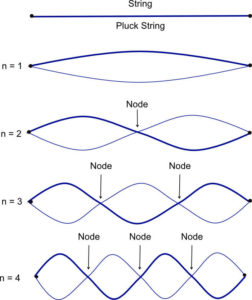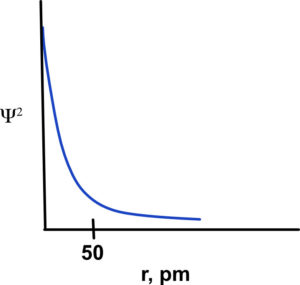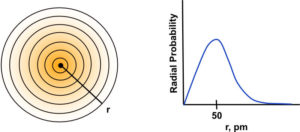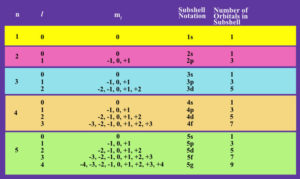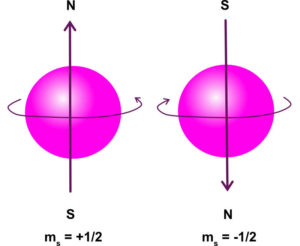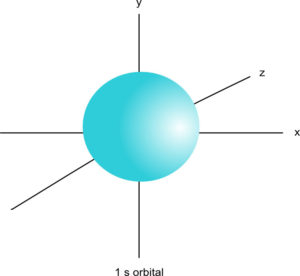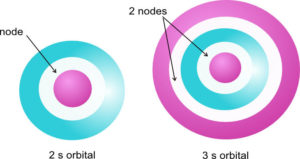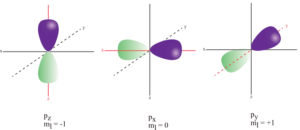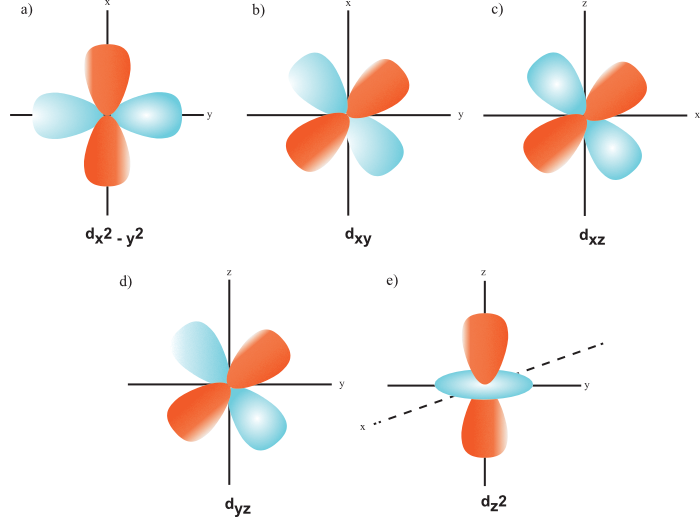Erwin Shrödinger (1887 – 1961), an Austrian physicist, introduced an equation called the Shrödinger equation:
where, Η is the Hamiltonian operator, E is the energy, and Ψ is the wave function. The square of the wave function, Ψ2 gives the probability density which is a measure of the probability of finding an electron of a particular energy in a particular region of the atom — the orbital. The Shrödinger equation involves advanced calculus so we will just focus on the main points here. An orbital is a mathematical function that describes the matter wave of an electron — it describes the region in space where there is a high probability of finding an electron.
Shrödinger treated the electron like that of a wave on a plucked guitar string. The string is fastened on both ends and does not travel in space, therefore, it is called a standing wave. When the string is plucked, the standing wave has a fundamental frequency (n = 1) and overtones that correspond to the lowest energy and highest energy of the waves of the electron. The nodes are regions of zero amplitude and we can see, in the figure below, the number of nodes increase with n. For n = 1, there are zero nodes, for n = 2 there is one node, for n = 3, there are 2 nodes, and so on.
Quantum mechanics does not allow the electron of the hydrogen atom to travel in an orbit, but it does allow us to find the location where there is a high probability of finding the electron. It is the square of the wave function, Ψ2, that gives us the probability of finding the electron within a region of space in the atom. The square of the wave function, Ψ2, gives us values for all of the regions around the nucleus. In the figure below is a plot of Ψ2 for the lowest energy level of the hydrogen atom. We can see Ψ2 decreases as we get further away from the nucleus. It is largest at r = 0 indicating a very high probability of finding the electron near the nucleus. Note that Ψ2 never goes to zero which indicates there is no definite boundary. In other words, the electron does not travel in a defined orbit.
Below is a figure of the probability of finding the electron in a hydrogen atom in different shells. The probability of finding the electron closer to the nucleus is high, but the size of the shells closest to the nucleus of the atom are small compared to the upper level shells. The probability of finding an electron within a shell is high with some distance from the nucleus. The distance is equal to the radius of an orbit calculated by Bohr.
Quantum Numbers. We can describe the electron in the hydrogen atom with four quantum numbers — n, l, ml, and ms. Below are the descriptions of each quantum number.
2. Angular Momentum Quantum Number, l. This quantum number is also called the Azimuthal Quantum Number. The angular momentum quantum number l, is an integer that can have values from 0 to n – 1. In each shell of quantum number, n, there are n different types of orbitals each with a different shape. The orbital shape is indicated by l. If the principal quantum number is equal to 4, n = 4, the possible values of l are 0, 1, 2, and 3. If the principal quantum number is equal to 3, n = 3, the possible values of l are 0, 1, and 2.
For the electron in the hydrogen atom it is only n that determines the energy of the electron. For multi-electron atoms, the energy of an orbital increases with increasing l. Within each principle energy level (shell) are subshells that are indicated using spectroscopic notation. There are s, p, d, f, g, … subshells.
To indicate a particular subshell within a principle energy level, n, write the value of n and then the letter of the subshell. For example, 3p is a p subshell located in n = 3.
3. Magnetic Quantum number, ml. This quantum number describes the orientation in space of an orbital in a subshell. The allowed values are integers from –l to +l. There is only one orbital in an s subshell and ml = 0. In a p subshell there are 3 orbitals and the allowed values for ml are -1, 0, +1. See the table below and become familiar with the quantum numbers.
4. Spin Quantum number, ms. This quantum number has two possible values; +1/2 or -1/2. The two electrons in an orbital must have opposite spin. The electron spins on its axis and the charge generates a magnetic field. The electron behaves similar to a small magnet.
Orbitals
The s orbitals are spherical in shape. The value of l for an s orbital is 0 and that makes ml = 0. There is only one s orbital in each principle energy level. For the 1s orbital, the probability is maximum at a 0.5 Å distance from the nucleus. At greater distances, the probability approaches zero.
The 2s orbital is larger than a 1s orbital and there is a region of zero electron density called a node in a 2s orbital. The 3s orbital is even larger and it has 2 nodes. The number of nodes increases with n, and the electron density becomes more spread out with increasing n. Recall, the electron behaves as a wave, and the different colors in the figure are due to the phases of the waves.
There are three p orbitals in a p subshell. All shells starting with n = 2 have three p orbitals. The p orbitals consist of two lobes on either side of the nucleus with a node at the nucleus. The angular momentum quantum number l is equal to 1, and ml can have values of -1, 0, and +1 to show the orientation of each orbital. The lobes of the orbitals are aligned along the axes. The lobes of one orbital are aligned along the z axis, pz, another one along the y axis, py, and one along the x axis, px. At the nucleus is a node, and the electron cannot get as close to the nucleus as it can in an s orbital. Just like s orbitals, the p orbitals increase in size as we go from the 2p to 3p to 4p and so on.
There are 5 d orbitals starting in the 3d subshell. For the d subshell l = 2 and ml can have values of -2, -1, 0, +1, and +2. The orientation and shapes of the d orbitals are more complex than either the s or p orbitals. Four of the orbitals have a cloverleaf shape (4 lobes) and one of the orbitals, dz2 has two lobes oriented along the z axis with a donut shape in the xy plane. The dxz, dyz, and dxz xy have the four lobes in the corresponding plane while the dx2 – y2 has the lobes lying along the x and y axis. Despite the differences in shapes of the d orbitals, they all have the same energy in a principal energy level, n.
The f orbitals are much more complex than the d orbitals and they are not presented here. There are 7 f orbitals with l = 3 and possible values of ml are -3, -2, -1, 0, +1, +2, and +3. We do not deal with f orbitals in General Chemistry, but you need to know about them in order to write electron configurations and draw orbital box diagrams.
When assigning quantum numbers to electrons, the lowest energy orbitals fill first. Recall, an orbital can hold a maximum of 2 electrons. The filling order is:
1s→2s→2p→3s→3p→4s→3d→4p→5s→4d→5p→6s→4f→5d→6p→7s→5f→6d→7p
Note how the 3d subshell fills after the 4s subshell. This is because the 4s subshell is a bit lower in energy than the 3d subshell in a multielectron atom. We will discuss the energy crossovers in the next study guide. In n = 1 there is one s subshell consisting of one s orbital, in n = 2, there are s and p subshells with three orbitals in a p subshell, in n = 3, there are s, p, and d subshells with 5 orbitals in the d subshell, and in n = 4, there are s, p, d, and f subshells with 7 oribitals in the f subshell.
Worksheet: Shells, Subshells, and Quantum Numbers
Worksheet: Orbitals
Worksheet: Quantum Numbers and Orbitals
Worksheet: Assignment of Quantum Numbers to Electrons
Exercises
Exercise 1. Assign 4 quantum numbers to each of the following electrons.
b) a 4d electron
c) a 4f electron
d) a 3p electron
Exercise 2. Which of the following sets of quantum numbers are not allowed. Explain your answer.
b) n = 2, l = 3, ml = 0, ms = +1/2
c) n = 3, l = 2, ml = -1, ms = +1/2
Exercise 3. What is the maximum number of electrons allowed in n = 4? n = 6?
Exercise 4. Assign 4 quantum numbers to each of the electrons in a carbon atom.
Exercise 5. Assign 4 quantum numbers for the outermost 2 electrons of germanium, Ge.
Check Solutions/Answers to Exercises
Back to Electronic Structure of Atoms
Back to General Chemistry 1 Study Guides
Back to Home Page

